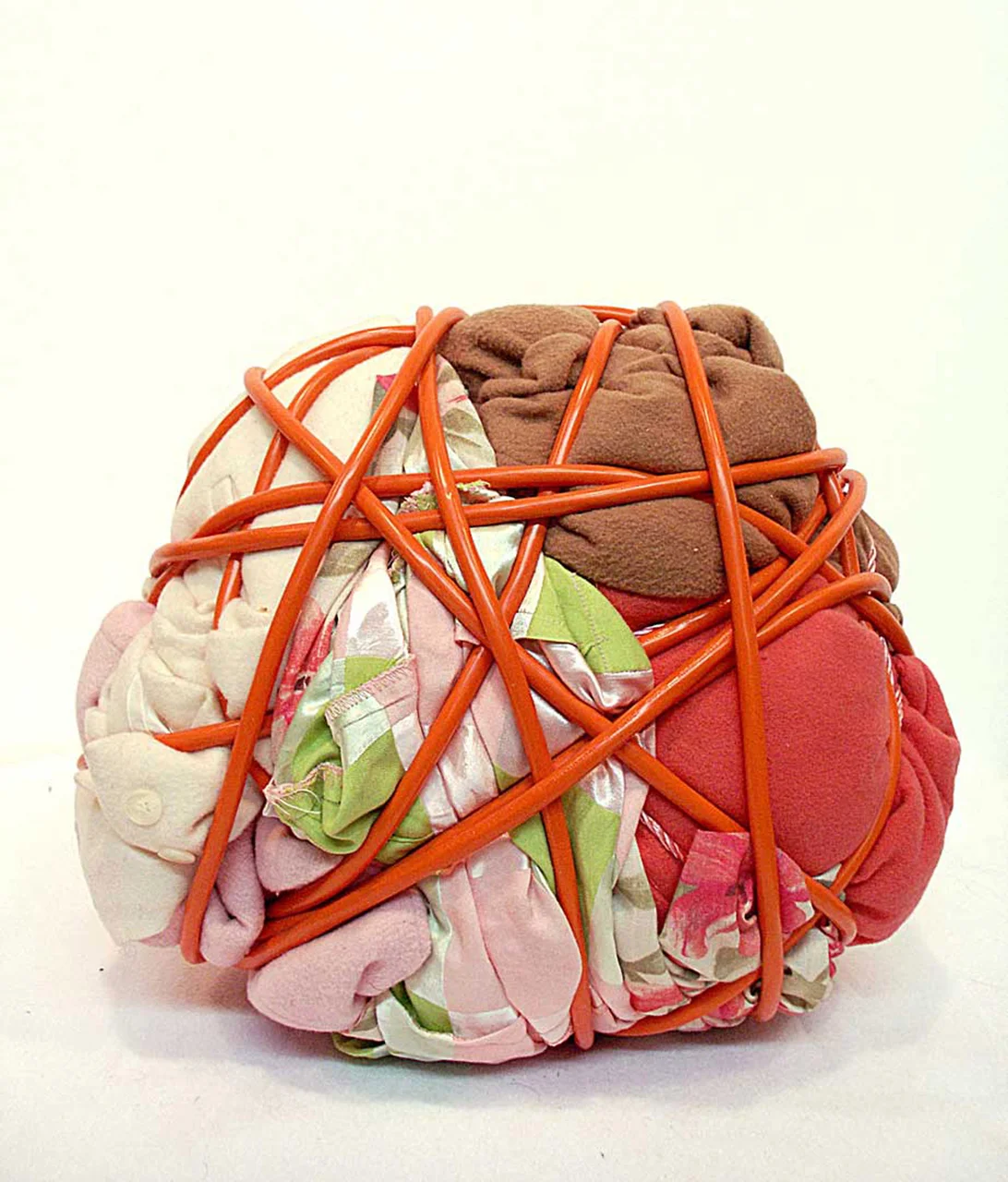
SHINIQUE SMITH. “LOUISE BUNDLE” (2006). CLOTHING AND ELECTRICAL CORD. DIMENSIONS VARY. COURTESY THE ARTIST AND MOMA PS1, NEW YORK. PHOTO: JASON KEELING.

SHINIQUE SMITH. “BRIGHT MATTER” (2013). CLOTHING, FABRIC, AND RIBBON ON WOOD PANEL. 63 X 52 X 5 INCHES. COURTESY THE ARTIST AND HAUSER WIRTH & SCHIMMEL, LOS ANGELES. PHOTO: ADAM REICH.
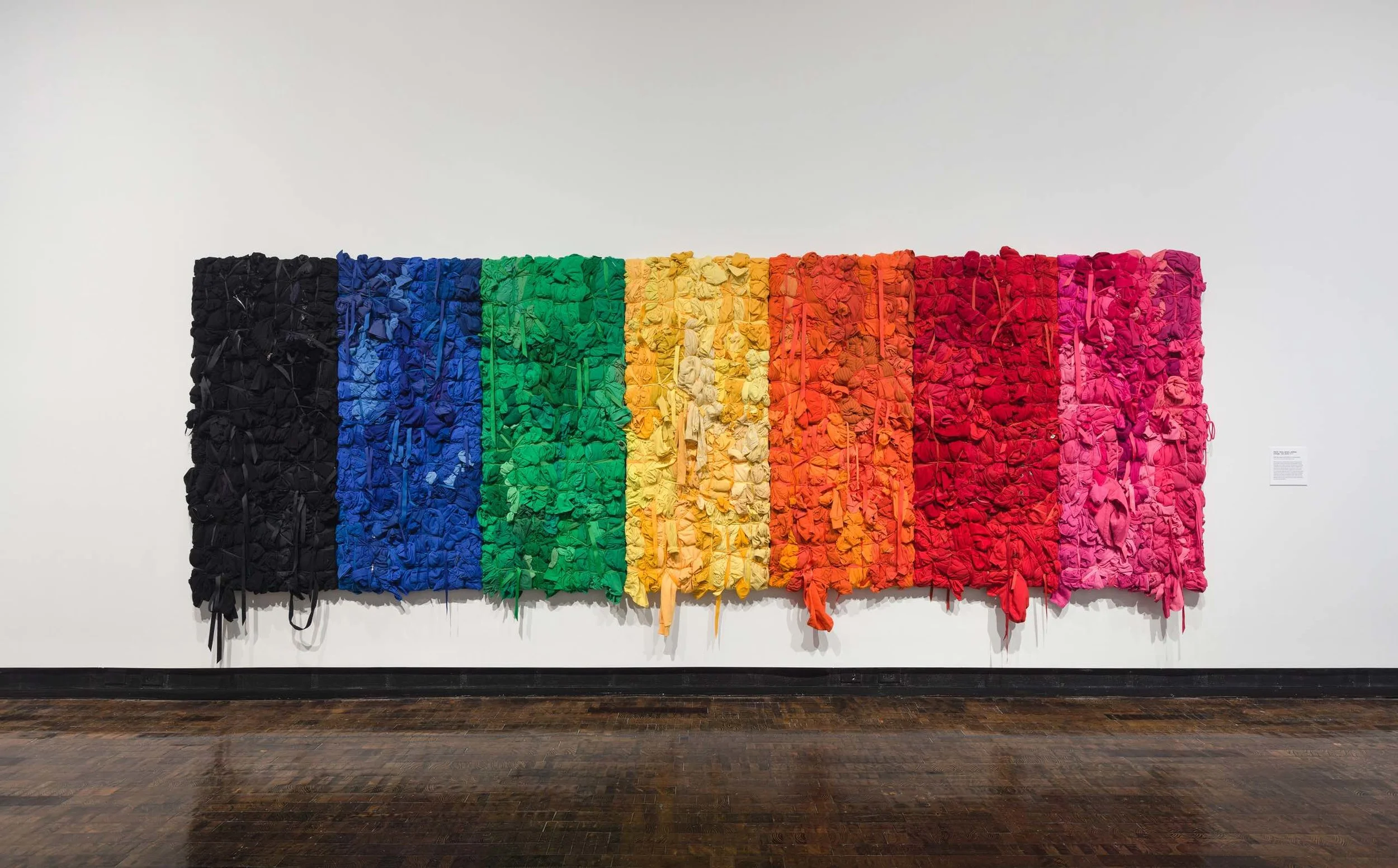
SHINIQUE SMITH. “BLACK/BLUE/GREEN/ YELLOW/ORANGE/RED/PINK” (2015). CLOTHING, FABRIC, AND RIBBON ON WOOD PANEL. 196 X 72 X 6 INCHES. COURTESY THE ARTIST AND HAUSER WIRTH & SCHIMMEL, LOS ANGELES. PHOTO: JOHN SCHWEIKER.
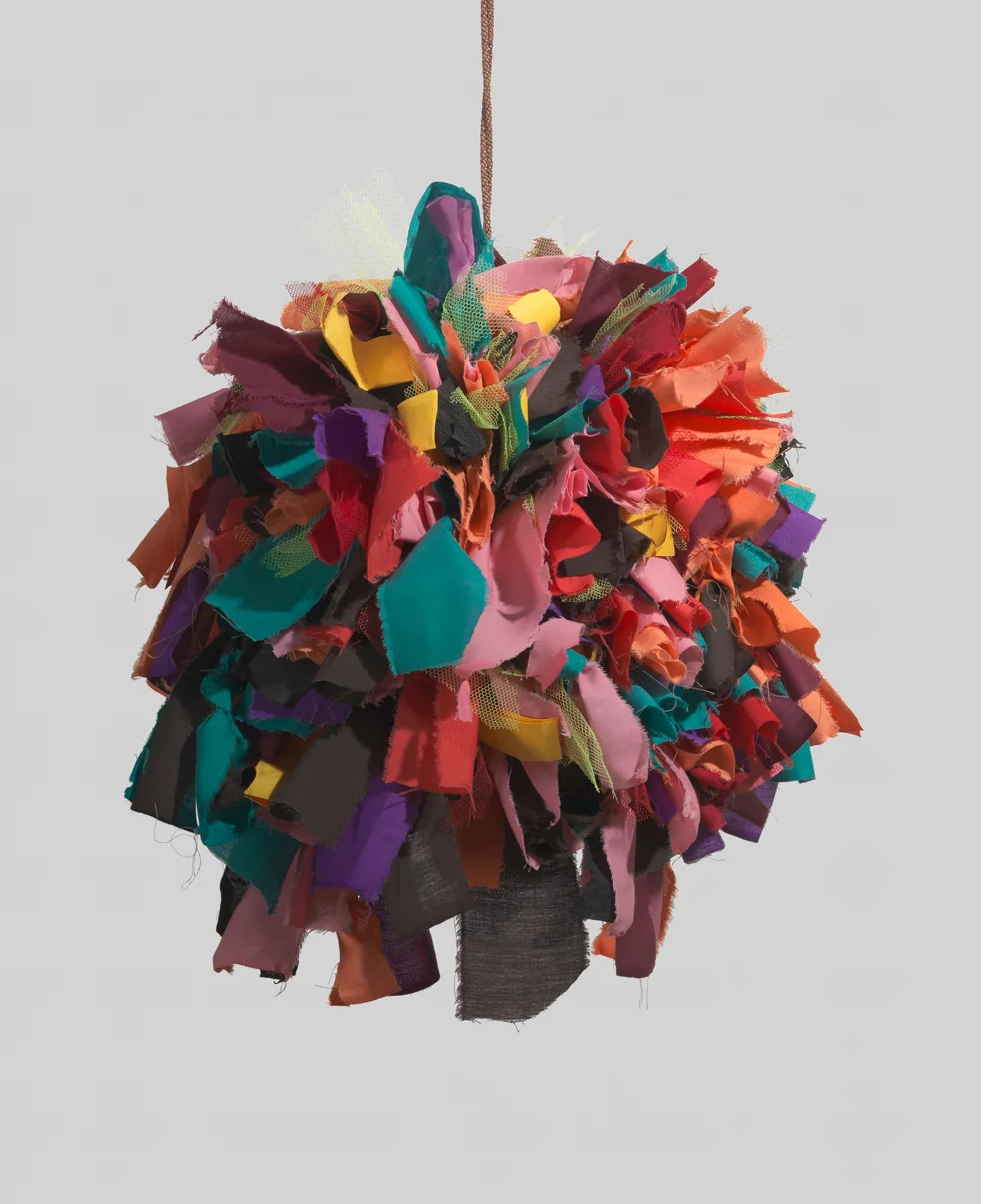
PHYLLIDA BARLOW. “UNTITLED: GIG” (2014). FABRIC, PAPER, CORD. 11 3/4 X 11 3/4 X 11 3/4 INCHES. COURTESY THE ARTIST AND HAUSER WIRTH & SCHIMMEL, LOS ANGELES. PHOTO: ALEX DELFANNE.
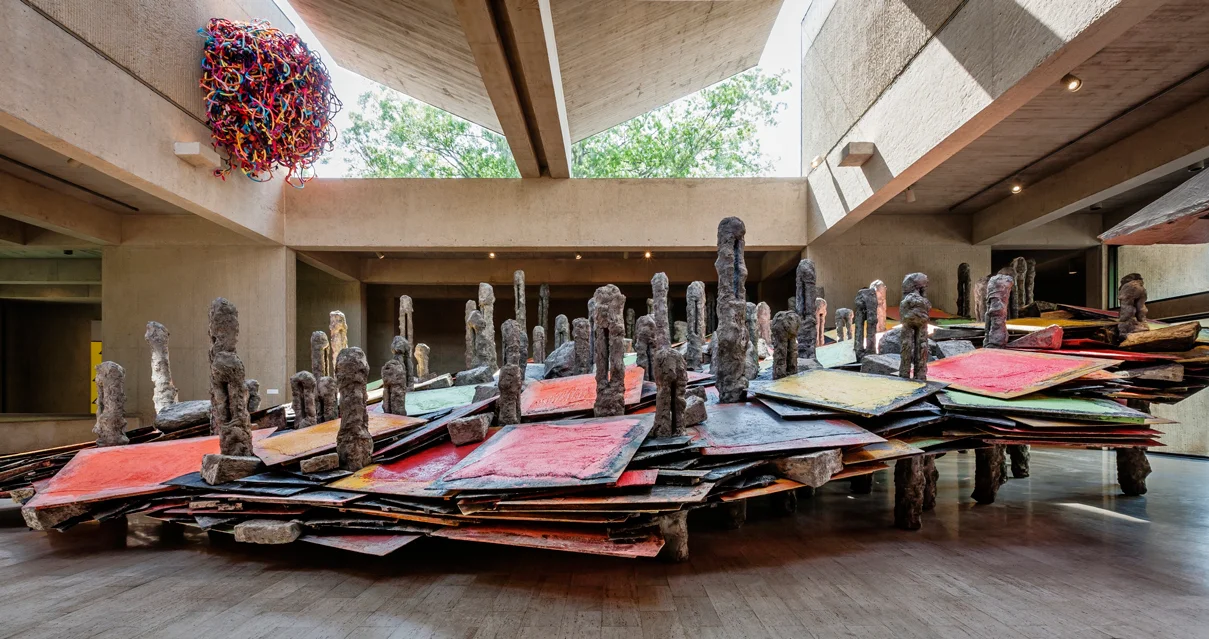
PHYLLIDA BARLOW. INSTALLATION VIEW, “UNTITLED: SCREESTAGE” (2013). STEEL ARMATURE, TIMBER, PLYWOOD, SCRIM, CEMENT, POLYURETHANE FOAM, PVA, PAINT. 168 X 689 X 624 INCHES. COURTESY THE ARTIST; DES MOINES ART CENTER, DES MOINES; HAUSER WIRTH, & SCHIMMEL, LOS ANGELES. PHOTO: PAUL CROSBY.
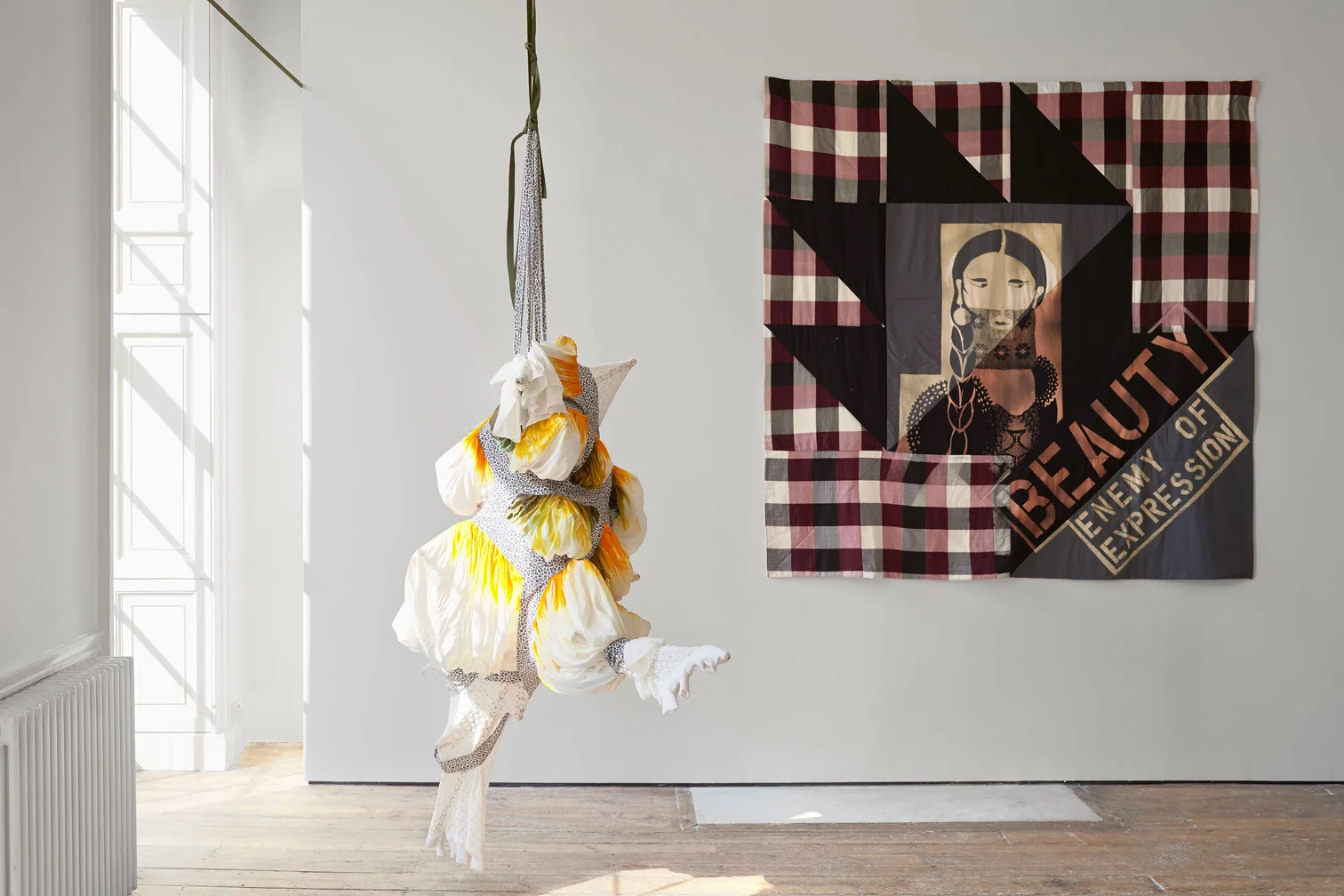
LARA SCHNITGER. INSTALLATION VIEW, LARA SCHNITGER (2014). COURTESY THE ARTIST AND STUART SHAVE/ MODERN ART, LONDON.
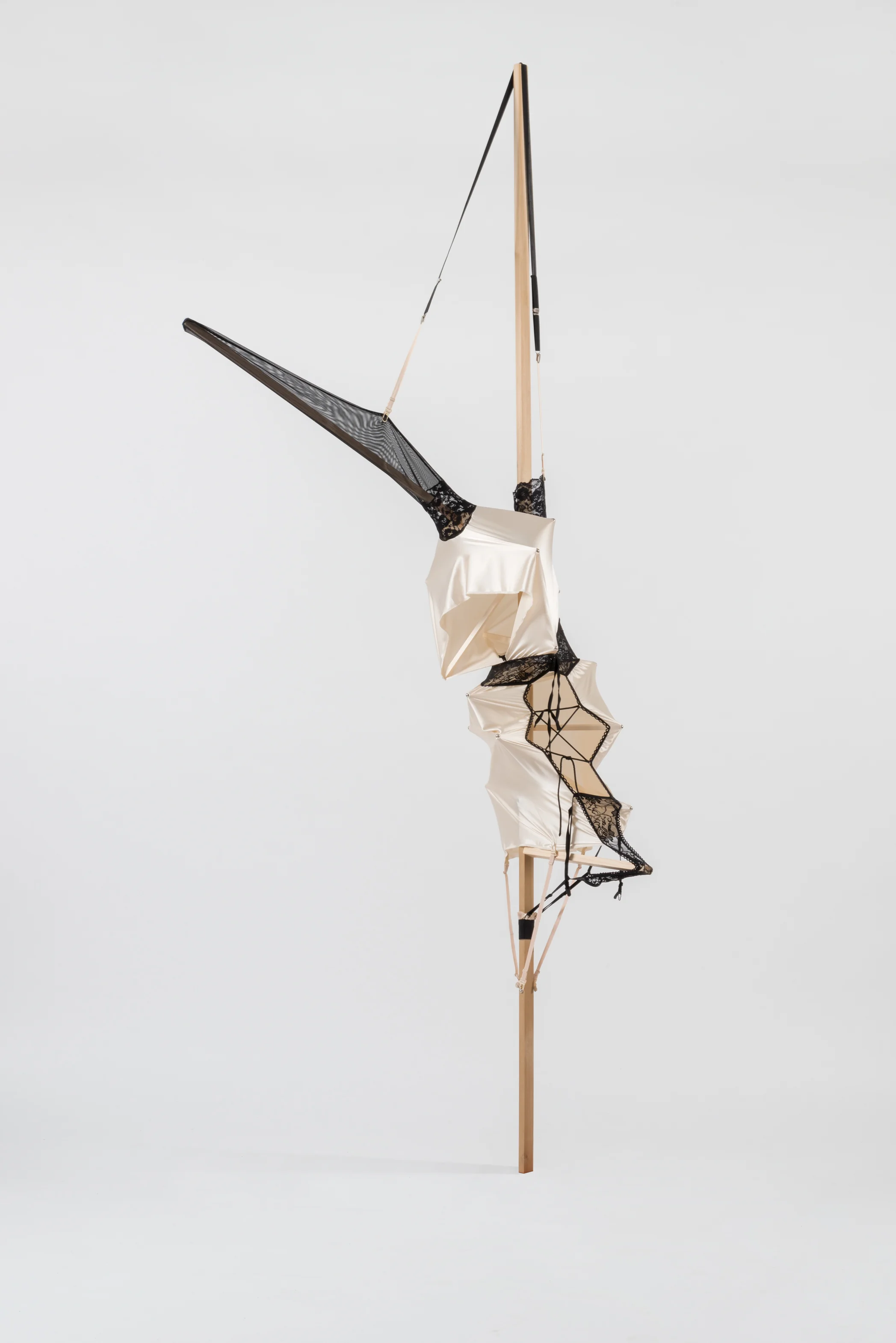
LARA SCHNITGER. “SLUT-STICK NOT A YES” (2015). SILK, LACE, ELASTIC, NYLON, METAL CLIPS, WOOD. 120 X 52 X 26 INCHES. COURTESY THE ARTIST AND ANTON KERN GALLERY, NEW YORK; STUART SHAVE/ MODERN ART, LONDON. PHOTO: JOSHUA WHITE STUDIO.

URSULA VON RYDINGSVARD. “BENT LACE” (2014). BRONZE. 112 X 69 X 40 INCHES. COURTESY THE ARTIST; HAUSER, WIRTH & SCHIMMEL, LOS ANGELES; AND THE MUSEUM OF MODERN ART, NEW YORK. PHOTO: JOHN WRONN.
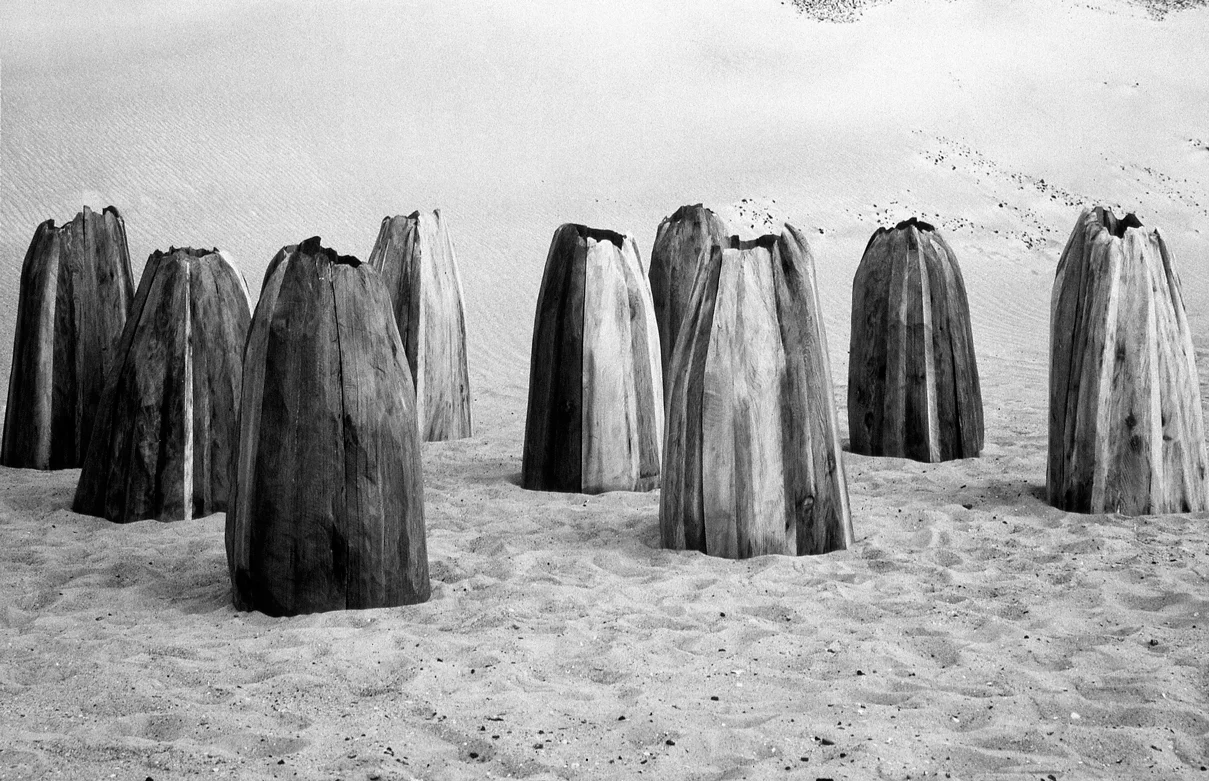
URSULA VON RYDINGSVARD. INSTALLATION VIEW, “UNTITLED (NINE CONES)” (1976). CEDAR. 42 X 180 X 156 INCHES. COURTESY THE ARTIST; HAUSER, WIRTH & SCHIMMEL LOS ANGELES; AND GALERIE LELONG, NEW YORK.
[](#)[](#)
These Four Artists Prove The L.A. Art Scene Is Only Getting Brighter
Hauser Wirth & Schimmel's 100,000 square foot campus is now open to the public.
The detective novels of Agatha Christie—_The Body in the Library_, _Cards on the Table_, 4_:50 From Paddington_, _And Then There Were None_—although legion, are delightfully formulaic. Christie’s victims are featureless, her detectives endearing, her suspects upstanding—until one’s Achilles heel is revealed (most often debt, occasionally pride or lust)—it’s all quite civilized. Secrets in a Christie novel, even murderous ones, never threaten the fabric of civility, and order is restored at the end of the book.
Secrets in the art world are treated as a matter of course. An artist’s studio is a sanctuary where his or her influences, thoughts, and craft are distilled and amalgamated into (capital A) Art.
Nearly everyone in the Art speaking world knows about Hauser & Wirth’s new Los Angeles Art Center: Hauser Wirth & Schimmel, but that hasn’t dampened the excitement and the sense of foreboding around it’s opening.
Coming from the monumental blue chip gallery that was started in Zürich by Iwan and Manuela Wirth and Manuela’s mother, Ursula Hauser—the campus-sized space in L.A. has been created in conjunction with their newest partner, former MoCA curator Paul Schimmel. Similar to its sister, Hauser & Wirth Somerset—an arts center focused on education based in the English countryside—Hauser, Wirth & Schimmel aims to be much more than a gallery. Calling it a cultural destination, the multi-building, hundred thousand square-foot space in the former Globe Mills complex will incorporate areas for longer-term museum-quality exhibitions, as well as room for emerging artists, a bookstore, and a bar and restaurant.
“I think there are certain facilities that when they opened \[in L.A.\], they really helped people to re-imagine what these facilities are about,” Paul Schimmel said, when asked what he hopes Hauser Wirth & Schimmel will add to the texture of the arts in L.A., “and in the case of Hauser Wirth & Schimmel, it’s really a gallery as a destination rather than a place where you just come to see an exhibition.”
The inaugural show—entitled Revolution in the Making: Abstract Sculpture by Women, 1947-2016—will focus on female abstract sculptors who are involved in every stage of their work. I spoke to curator Jenni Sorkin—a scholar of feminism—about a few of the considerations that went into the selection process. “The idea was to actually stay away from identity politics and really focus on abstraction and artists who work in their studios and make things by themselves,” Sorkin said. “Historically women have not had the opportunity to make work in that way, and are confined to men making their work in foundries and outsourced fabrication spheres. Women have been excluded from sculpture historically, it’s one of the last bastions that has been very masculine.”
The popularity of the detective novel in general, and Christie in particular—who, although a few of the 82 books she wrote are enduring classics, is not generally known as a master of her craft—has been a subject of much study. Through the lens of her various techniques—The Red Herring, The Confidante, The Privileged Information, and The Restoration of Order—we study four artists featured in Revolution in the Making.
**I. THE RED HERRING**
Although not a secretive person in general, Shinique Smith—the Upstate New York-based artist working primarily with cast-off items of clothing—does not like to give her viewers too many clues, “In terms of making art, I feel like sometimes I hold back on explaining the work—sometimes subconsciously—because I don’t want to take away the mystery of discovering that for the viewer.”
Having shown at prestigious venues such as The Museum of Fine Arts, Boston, Los Angeles County Museum of Art, The Smithsonian National Portrait Gallery, The New Museum, and MOMA/PS1, Smith is one of the few younger working artists to be chosen to create a large site-specific work incorporating her practice of bundling and dying fabric from cast-off clothing, as well as painting and mixed media. “Clothing and fabric has been around me a long time, since I was a kid. My mom designed clothes, went to FIT to study fashion, so there was always fabric around, I was always dragged in and out of that, exposed to vintage shops and things like that, so I guess, by osmosis, I developed an affinity to it.”
[](http://images.squarespace-cdn.com/content/v1/56c346b607eaa09d9189a870/1487292533569-2RAU2PIIERIYPDS8DJPR/7.Smith_Black-Blue-Green-Yellow-Orange-Red-Pink_01_Photo-by-John-Schweikert.jpeg_Black-Blue-Green-Yellow-Orange-Red-Pink_01_Photo-by-John-Schweikert.jpeg?format=original)
_Shinique Smith. “Black/Blue/Green/ Yellow/Orange/Red/Pink” (2015). Courtesy the artist and Hauser Wirth & Schimmel. Photo by John Schweiker._
_[](http://images.squarespace-cdn.com/content/v1/56c346b607eaa09d9189a870/1487292534701-IDUBE790F3IM41F9MCKA/8.SMITH_Bright-Matter_2013_JCG6265.jpeg_Bright-Matter_2013_JCG6265.jpeg?format=original)_
_Shinique Smith. “Bright Matter” (2013). Photography: Adam Reich._
**II. THE CONFIDANTE**
Phyllida Barlow—the celebrated, but perhaps under-known British artist and teacher, whose large-scale works in timber, concrete, and fabric seem to mock gravity—does not like secrets. “I think a secret is very different from respecting someone’s privacy,” Barlow relates, “I think secrets can be dangerous, openness is maybe a preferred quality.”
Barlow’s pieces, exemplified especially by her masterful work created for the Tate Britain Commission in 2014, teeter on the edge of destruction, or sometimes embrace it. There is in her work a gleeful undoing, “I like the idea of things being caught off-guard or something being over-heavy,” Barlow said, “and then the structures that are needed to counterbalance that become as excessively cumbersome. Gravity becomes something that determines the form of the work and can be used—as well as giving, maybe, a sense of danger or the feeling of an impending accident.”
[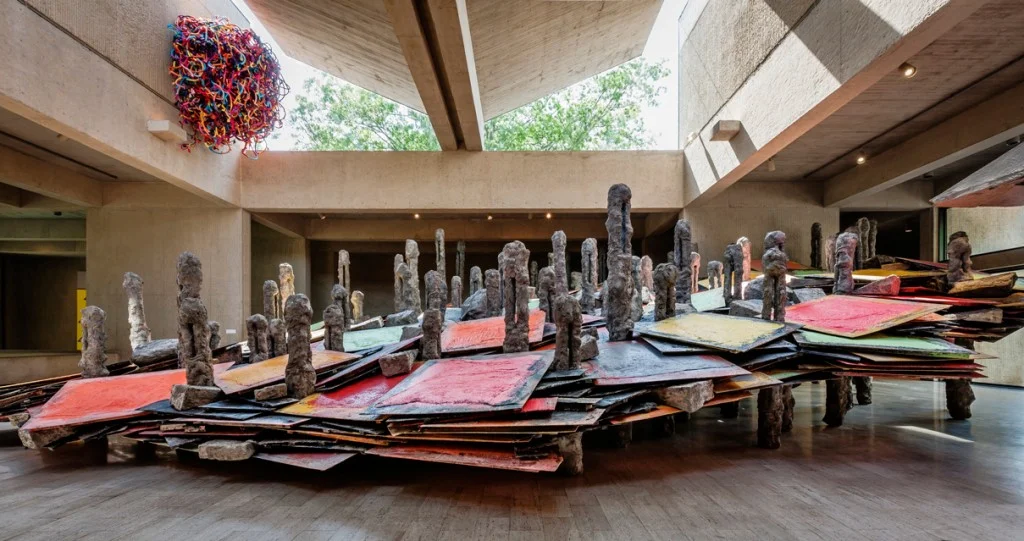](http://images.squarespace-cdn.com/content/v1/56c346b607eaa09d9189a870/1487292551889-IHHLP39WK0SLUNGOCAN4/BARLO56921.jpg)
_Phyllida Barlow. Installation view, "Untitled: Screestage" (2013). Photography: Paul Crosby._
[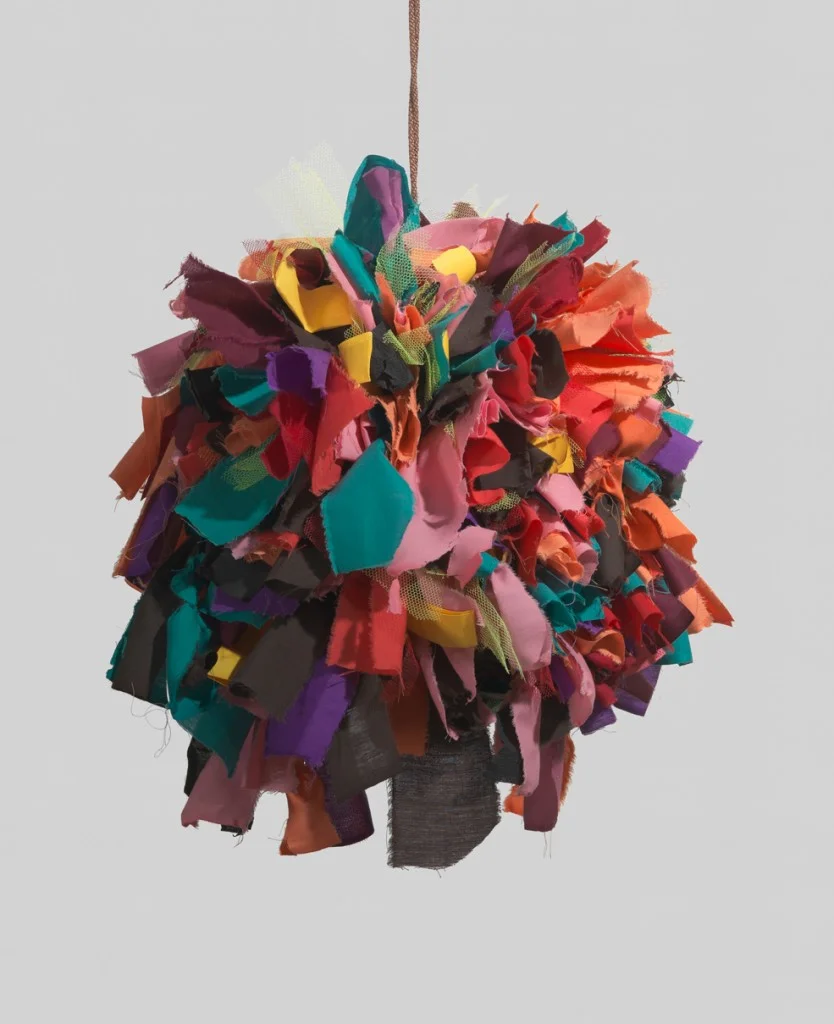](http://images.squarespace-cdn.com/content/v1/56c346b607eaa09d9189a870/1487292552357-56BSJI9FUKQMKVL7B08F/BARLO64316.jpg)
_Phyllida Barlow. “Untitled: Gig" (2014). Photography: Alex Delfanne._
**III. THE PRIVILEGED INFORMATION**
The L.A.-based Dutch artist Lara Schnitger—another of the younger generation of female abstract sculptors chosen to create work for Revolution in the Making—believes secrets are an essential element of making art, “I think the studio practice is very secretive. You know, I think as an artist, you have a lot of secrets, even secrets about your work, and I think there are secrets in the studio that I might still have to discover for myself.”
Schnitger’s practice—often incorporating textiles thrown around wooden beams with titles such as “Slut-stick Hemline,” “Proud Slut,” and “Walking Nude,”—embraces sculpture, video, and photography, weaving textiles with social codes. Although her work could be interpreted as overtly feminist, it does not fit easily into the category. “I make sculptures because I want people to go up to them, and in them, and touch them, or want to touch them, or feel one-to-one with them, maybe feel dwarfed by them, or feel giant because they’re next to them.” Schnitger says, “What I love from this show is that all these artists are featured as being sculptors, and they’re also women.”
[](http://images.squarespace-cdn.com/content/v1/56c346b607eaa09d9189a870/1487292599288-D6INIOE7AM3V0E7DDKNV/LS_15S_Slut-stickNotAYes_ak11488.jpg)
_Lara Schnitger. “Slut-Stick Not A Yes" (2015). Photography: Joshua White Studio._
[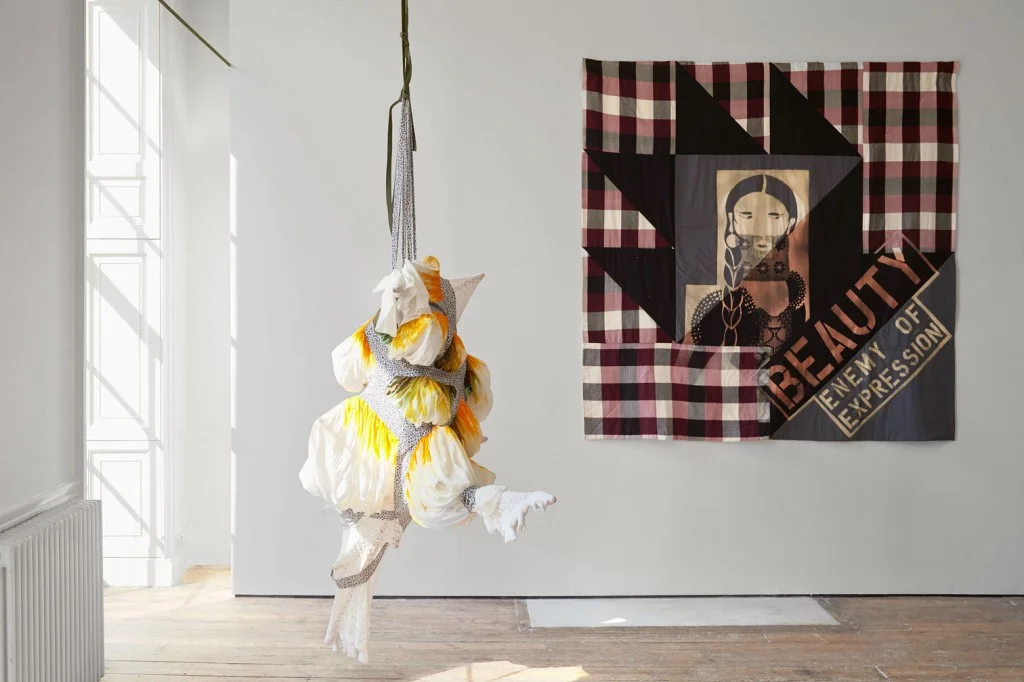](http://images.squarespace-cdn.com/content/v1/56c346b607eaa09d9189a870/1487292522865-I8JM1PNGTCXQYH4QTRZ8/2015_StuartShaveModernArt_SCHNIT.jpg)
_Lara Schnitger, Installation View,_ Lara Schnitger _(2014)._
**IV. THE RESTORATION OF ORDER**
Ursula von Rydingsvard—the established German-born sculptor who has worked primarily in four-by-four-inch hand-hewn cedar beams—is a woman with a few secrets: “I do \[keep secrets\], and a lot of them; because I feel like there are some things that are only consequential to me or there are some things that I don’t necessarily want to share with others.”
Von Rydingsvard’s practice, which, in recent years has seen her branch into cast copper and bronze, always starts with the wood, “What I constantly do every time that a flatbed comes from Vancouver with my cedar, I say to myself, ‘Ursula, you have to stop this, it’s too much, you’ve done it for too long.’ \[...\] But there’s something about the way that I’m able to control cedar, it’s like no other material, I can get it to say all those little subtle things that are very difficult for me to get. I used to work in stone a little bit, I worked in clay, a little bit. I couldn’t get it in those materials. So there’s a kind of soulfulness that I can eek out of the cedar that I use for my work.”
[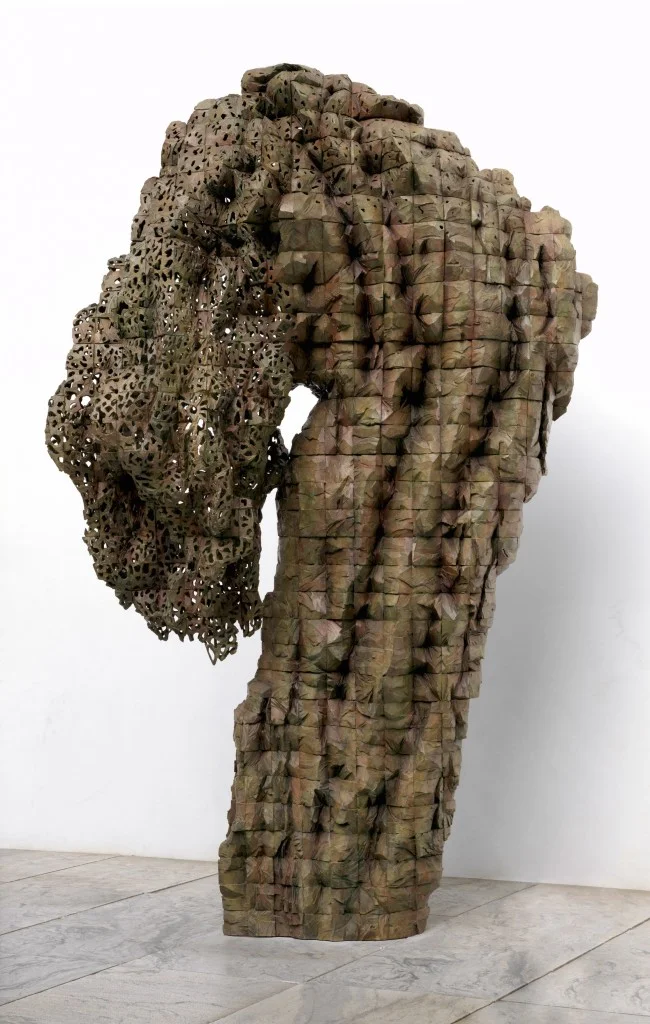](http://images.squarespace-cdn.com/content/v1/56c346b607eaa09d9189a870/1487292658876-A6AYN0ROGD0LMDJ15E0K/this.jpg)
_Ursula von Rydingsvard. "Bent Lace" (2014). Photography: John Wronn._
[](http://images.squarespace-cdn.com/content/v1/56c346b607eaa09d9189a870/1487292649579-WJ6QREQWKLLHJFCT1BPH/VONRY70417.jpg)
_Ursula von Rydingsvard. "Untitled (Nine Cones)" (1976)._
_Revolution in the Making: Abstract Sculpture by Women’ will be on view at Hauser Wirth & Schimmel daily from Wednesday, Friday – Sunday: 11 am – 6 pm and Thursday: 11 am – 8 pm, from 13 March through 4 September, 2016. [More info here](http://www.hauserwirthschimmel.com/exhibitions/revolution-in-the-making-abstract-sculpture-by-women-1947-2016-20160313)._
_Follow Amy Marie Slocum on Instagram ([@amymarieslocum](https://www.instagram.com/amymarieslocum/)) for more things art and archaic._
